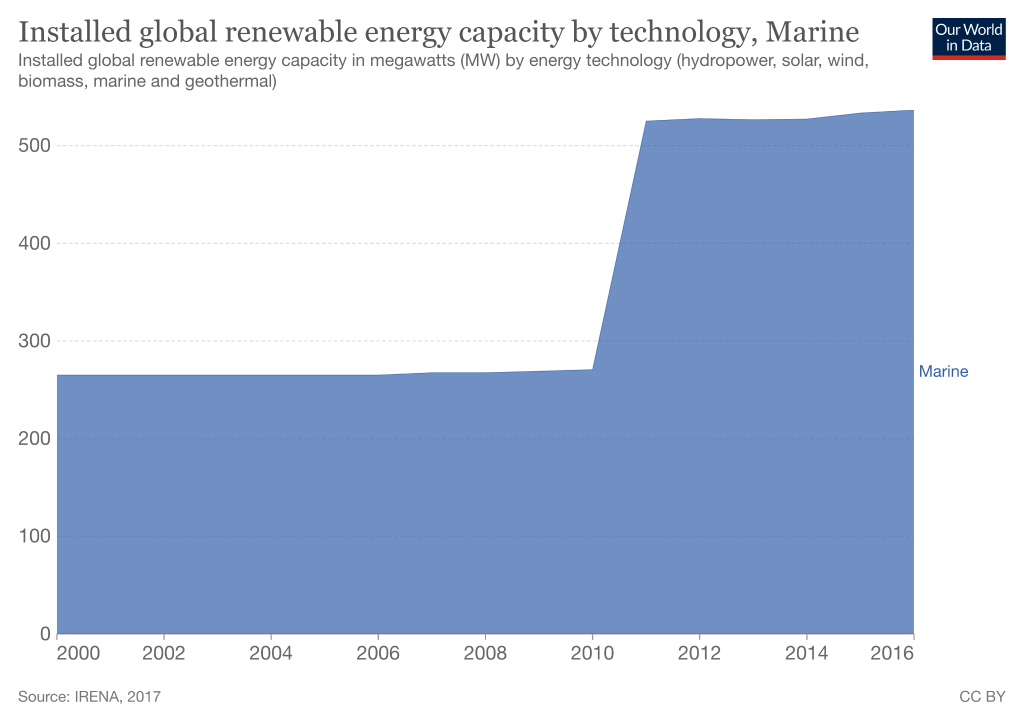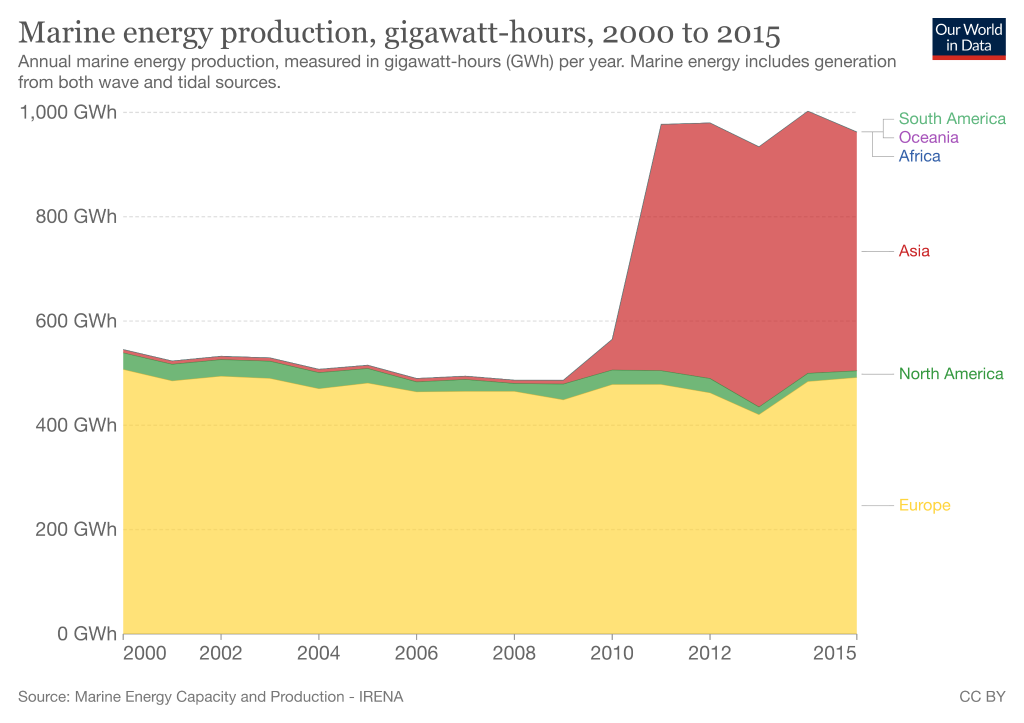What Is the Carbon Footprint of Tidal Energy and Wave Energy? A Life-Cycle Assessment
Impactful Ninja is reader-supported. When you buy through links on our site, we may earn an affiliate commission.
Learn more
Learn more
.
Hey fellow impactful ninja ? You may have noticed that Impactful Ninja is all about providing helpful information to make a positive impact on the world and society. And that we love to link back to where we found all the information for each of our posts. Most of these links are informational-based for you to check out their primary sources with one click. But some of these links are so-called "affiliate links" to products that we recommend. First and foremost, because we believe that they add value to you. For example, when we wrote a post about the environmental impact of long showers, we came across an EPA recommendation to use WaterSense showerheads. So we linked to where you can find them. Or, for many of our posts, we also link to our favorite books on that topic so that you can get a much more holistic overview than one single blog post could provide. And when there is an affiliate program for these products, we sign up for it. For example, as Amazon Associates, we earn from qualifying purchases. First, and most importantly, we still only recommend products that we believe add value for you. When you buy something through one of our affiliate links, we may earn a small commission - but at no additional costs to you. And when you buy something through a link that is not an affiliate link, we won’t receive any commission but we’ll still be happy to have helped you. When we find products that we believe add value to you and the seller has an affiliate program, we sign up for it. When you buy something through one of our affiliate links, we may earn a small commission (at no extra costs to you). And at this point in time, all money is reinvested in sharing the most helpful content with you. This includes all operating costs for running this site and the content creation itself. You may have noticed by the way Impactful Ninja is operated that money is not the driving factor behind it. It is a passion project of mine and I love to share helpful information with you to make a positive impact on the world and society. However, it's a project in that I invest a lot of time and also quite some money. Eventually, my dream is to one day turn this passion project into my full-time job and provide even more helpful information. But that's still a long time to go. Stay impactful,Affiliate Disclosure
Why do we add these product links?
What do these affiliate links mean for you?
What do these affiliate links mean for us?
What does this mean for me personally?
![]()
Often referred to as one of the last untapped natural resources, tidal and wave energy are known to have a large generating potential while promising one of the lowest levels of carbon dioxide emissions. So we had to ask: What is the carbon footprint of tidal and wave energy?
Tidal and wave energy have one of the lowest carbon footprints of all energy types. On a life-cycle basis, tidal energy emits less than 22 gCO2 and wave energy emits similarly low levels of CO2 (although more research is needed). Both combat climate change and have various environmental benefits.
Tidal energy and wave energy (marine energy) have enormous potential to play a vital role in combating climate change. Keep reading to learn about the overall carbon footprint of tidal and wave energy, their carbon footprint throughout their life-cycles, and their environmental impact.
How are Tidal and Wave Energy Defined
The gravitational pull of the sun and moon coupled with the rotation of the earth creates tides in the ocean. To produce tidal energy, tidal turbines, barrages, and lagoons use the rise and fall of tides to spin a generator to produce electricity. A minimum tidal range of 10 feet is required to harness tidal energy economically.
“Tidal Power: power that comes from the movement of the tide (= the rise and fall of the ocean that happens twice every day) and that can be used especially for producing electricity”
Cambridge Dictionary
There are three types of tidal energy technology:
- Stream: turbines are placed in tidal streams. The machines are large and can disrupt the tides. The size of the turbine and the location of the tidal stream will dictate the level of environmental impact.
- Barrage: a barrage (dam) is placed across a river, bay, or estuary. The barrage gates open as the tide rises and close at high tide, creating a lagoon. The water is then released through the turbines which spin a generator to create electricity. Barrages cause significant land disruption within the tidal range, and the change in water and salinity levels within the lagoon can harm plant and animal life. Also, turbines in barrages move fast and can kill marine life in their blades.
- Lagoon: a body of ocean water is partially enclosed by a man-made barrier. Lagoons function in the same manner as a barrage, but they generate continuous power and can also be constructed along a coastline. Lagoons provide a minimal level of environmental impact but also generate the least amount of energy. They can be constructed with natural materials like rock and would easily allow marine life to pass through.
Waves are formed when the wind blows over the surface of the water on oceans or lakes. 95% of the wave’s energy is stored between the surface of the water and the top 1/4th of the wave’s length. To produce wave energy, float/buoy, oscillating water columns, and tapered channel systems use the rise and fall of waves to produce electricity.
“Wave Power: electrical energy generated by harnessing the up-and-down motion of ocean waves”
Britannica
There are three types of wave energy technology:
- Float or Buoy: Anchored buoys use the rise and fall of waves to power hydraulic pumps. The “up” and “down” movement powers a generator to produce electricity, which is transported onshore via underwater power cables.
- Oscillating Water Column: The “in” and “out” motion of waves at the shore enter columns, forcing air to turn turbines. As the waves enter the column, the air is compressed and heated, creating energy. The energy is then transported onshore via underwater power cables.
- Tapered Channel (Tapchan): Shore mounted structures channel and concentrate waves, pushing them into an elevated reservoir. The water is then released from the reservoir, flowing through penstocks and to turbines which power a generator to produce electricity.
Wave energy generation has the greatest potential at latitudes with the highest winds (40-60 degrees N and S) on the eastern shores of the world’s oceans, which are the western edges of the continents.
Tidal and wave energy are not as developed when compared to the traditional renewable energies (e.g. solar, wind, hydropower, biomass, and geothermal). This is largely due to a lack of funding because of the high upstart and maintenance costs. As technology becomes cheaper to implement, experts predict that tidal and wave energy will increase in production. In 2021, the US Department of Energy announced up to $27 million in federal funding for research and development to convert ocean waves into electricity.
What is the Carbon Footprint of Tidal and Wave Energy
The carbon footprint is one of the ways we measure the effects of human-induced global climate change. It primarily focuses on the greenhouse gas (GHG) emissions associated with consumption and includes other emissions such as methane (CH4), nitrous oxide, and chlorofluorocarbons (CFCs).
“Carbon footprint: the amount of greenhouse gases and specifically carbon dioxide emitted by something (such as a person’s activities or a product’s manufacture and transport) during a given period”
Merriam Webster
Basically, it is the amount of carbon emitted by an activity or an organization. This includes GHG emissions from fuel that we burn directly (e.g., heating a home, driving a car) and GHG emissions from manufacturing the products that we use (e.g., power plants, factories, and landfills).
What Is the Overall Carbon Footprint of Tidal and Wave Energy
Estimates for the life-cycle global warming emission of tidal energy are below 0.05 pounds (22 grams) of carbon dioxide equivalent per kilowatt-hour (gCO2 per KWh). More research needs to be performed on wave systems, but they also produce very little CO2 emissions. Tidal and wave energy produce a fraction of the emissions of coal power plants, which produce an estimated 820 gCO2 per KWh.
The global installed capacity of marine technology increased from 265 to 536 megawatts (MW) between 2000 and 2016.

Tidal and wave energy has seen a 102% increase in the past 20 years, but its development worldwide has been disproportionate. Only a few countries currently harness and produce tidal and wave energy.

The top 6 tidal energy-producing countries (amount per year) in the world are:
- South Korea – 511 MW
- France – 246 MW
- United Kingdom – 139 MW
- Canada – 40 MW
- Belgium – 20 MW
- China – 12 MW
The Sihwa Lake Tidal Power Station in South Korea is the largest operational tidal power plant in the world. Opened in 2011, it has a capacity of 254 MW and a 12.5 kilometer (7.8 foot) sea wall for flood mitigation and agricultural purposes.
The second-largest operational tidal power plant in the world is the La Rance Tidal Power Station in France. Opened in 1966, it consists of 24, 10 MW capacity turbines.
Similar to tidal power, very few countries produce wave power, with the energy currently being under research and development.
The Aguçadora wave farm in Portugal was the world’s first operational wave power system. It had a 2.25 MW generating capacity and consisted of jointed tubes that floated on the surface of the Atlantic Ocean and harnessed energy from the “up” and “down” motion of the waves. It was discontinued due to maintenance issues.
PacWave South, an Oregon State University-led project, is a 2 square mile patch of ocean located 7 miles off of the Oregon coast. Scheduled for completion in 2023, it is a site where companies and developers can test their wave energy technologies for eventual market use.
There are roughly 3,000 GW of energy stored in the world’s tides, and the market for wave energy is expected to reach $141 million by 2027. Because the generating potential for both tidal and wave energy is so high, it is important to understand what their carbon footprints are. And how their carbon emissions affect the global climate change process.
To understand the carbon footprint of tidal and wave energy, we must assess its life-cycle and each stage’s carbon footprint. This life-cycle assessment (LCA) is a method to evaluate the environmental impacts of products and materials. Over the years, companies have strategically used LCA to research and create more sustainable products. So, let’s have a look at the LCA of tidal energy!
| The life-cycle stages of tidal and wave energy | Each stage’s carbon footprint |
| Building of tidal and wave energy | CO2 emissions from construction and transportation of materials |
| Operating of tidal and wave energy | Little to no CO2 emissions or waste products |
| Building back of tidal and wave energy | Tidal: Theoretically none as tidal infrastructure can be maintained indefinitely Wave: More research is needed |
The total carbon footprint of tidal and wave energy would equal the carbon footprint from building + the carbon footprint from operating + the carbon footprint from building back.
What Is the Carbon Footprint of Building Tidal and Wave Energy
The carbon footprint of building tidal and wave energy includes emissions from the construction of the technologies and the power plants.
Transporting the materials to build the tidal and wave technologies and the power plants requires transportation methods that run on diesel fuel. Burning one gallon of diesel fuel produces 22.38 pounds of CO2.
Many components are required to construct tidal and wave power plants, and building these components requires machinery that emits CO2. For tidal energy, the dams, gates, turbines, and generators have a carbon footprint. For wave energy, the buoys, water columns, penstocks, turbines, and generators have a carbon footprint. The underwater transmission lines, transformers, and substations required for delivering electricity to consumers also all have a carbon footprint.
CO2 emissions at this stage occur when constructing the tidal and wave energy machinery and when transporting the materials needed in that construction.
What Is the Carbon Footprint of Operating Tidal and Wave Energy
Tidal energy operates in the following way:
- Stream: Moving water turns turbines in tidal streams. The turbines power generators which produce electricity.
- Barrage: A dam (dam) is placed across a river, bay, or estuary. As the tide rises, water enters the reservoir. When the water is released it passes through turbines, turning them and powering generators to produce electricity.
- Lagoon: These operate in the same manner as barrages, but they generate continuous power and can also be constructed along a coastline.
The electricity is then transported via underwater cables to a substation on land where it is transmitted to consumers by transmission lines. Transformers receive the electricity and either increase or decrease the voltage as needed before it can be delivered to consumers.
Wave energy operates in the following way:
- Float or Buoy: The “up” and “down” motion of waves moves buoys. The kinetic energy produced powers a generator to produce electricity.
- Oscillating Water Column: The “in” and “out” motion of waves at the shore enter columns, compressing and heating the air inside, turning turbines, and powering generators to produce electricity.
- Tapered Channel (Tapchan): Tidal waves are forced into an elevated reservoir. When water is released from the reservoir, it flows through penstocks, turns turbines, and powers generators to produce electricity.
The electricity is then transported to a substation where it is transmitted to consumers by transmission lines. Transformers receive the electricity and either increase or decrease the voltage as needed before it can be delivered to consumers.
There are very few CO2 emissions or waste products associated with operating tidal and wave energy, making the carbon footprint of this phase very low. CO2 emissions at this stage are associated with the operation of the mechanical equipment (e.g., turbines, generators, substations, transformers) at the power plants.
What Is the Carbon Footprint of Building Back Tidal and Wave Energy
Tidal power plants have an average life expectancy of up to 100 years. This makes them a long-term, reliable source of energy. And if tidal plants are properly maintained, the civil engineering infrastructure should last almost indefinitely. If this is the case, there might not be a building back phase, and there would not be a carbon footprint associated with this phase.
Little is known about the life expectancy of wave power plants because the technology is still in development and has not been implemented on a commercial scale for an extended period of time. Factors that should be taken into account when calculating the lifespan would include the physical force of the wave hitting the machinery and the saltwater’s corrosive abilities.
What Role Does Tidal and Wave Energy Play in Combating Climate Change
Fossil fuel combustion is the main contributor to atmospheric CO2 levels. Climate Change occurs when CO2 and other air pollutants absorb sunlight and solar radiation in the atmosphere, trapping the heat and acting as an insulator for the planet. Since the Industrial Revolution, Earth’s temperature has risen a little more than 1 degree Celsius (C), or 2 degrees Fahrenheit (F). The current global annual temperature rise is 0.18C, or 0.32F, for every 10 years.
Using tidal and wave energy instead of fossil fuel energy helps mitigate the following negative effects of climate change:
- Increasing temperatures: Earth’s atmosphere has warmed 1.5℃ since 1880. This may not seem like a lot, but these degrees create regional and seasonal temperature extremes, reduce sea ice, intensify rainfall and drought severity, and change habitat ranges for plants and animals.
- Rising sea levels: Global sea levels have increased approximately 8-9 inches since 1880, displacing people living along coastlines and destroying coastal habitats. Roads, bridges, subways, water supplies, oil and gas wells, power plants, sewage treatment plants, and landfills remain at risk if sea level rise goes unchecked.
- Melting of sea ice: Since 1979, arctic sea ice has declined by 30%. Sea ice plays a major role in regulating the earth’s climate by reflecting sunlight into space and providing habitat for animal species. If all of the glaciers on Earth melted, sea levels would rise by approximately 70 feet, effectively flooding out every coastal city on the planet.
- Changing precipitation patterns: Extreme weather events (e.g., hurricanes, floods, droughts) are becoming more common and more intense. Storm-affected areas will experience increased precipitation and flooding whereas areas located further from storm tracks will experience decreased precipitation and droughts.
- Ocean acidification: The ocean absorbs 30% of the CO2 released into the atmosphere, which decreases the pH (increases the acidity) of the ocean. In the past 200 years, the pH of oceans has decreased by 0.1 pH units, which translates to a 30% increase in acidity. Aquatic life unable to adjust to this rapid acidification will die off. A prime example of this is coral bleaching, where coral expel the algae (zooxanthellae) living in their tissues as a result of changes in temperature, light, or nutrients.
Experts claim that to avoid a future plagued by rising sea levels, acidified oceans, loss of biodiversity, more frequent and severe weather events, and other environmental disasters brought on by the hotter temperatures, we must limit global warming to 1.5C by 2040.
The more we reduce CO2 emissions, the more we slow the rate of temperature rise, sea-level rise, ice melting, and ocean acidification. When these rates are slowed, the earth’s biodiversity does not have to struggle to adapt to temperature and pH changes. People will not be displaced due to the flooding of coastal areas. And icebergs will continue to provide climate regulation.
How Environmentally Friendly Is Tidal and Wave Energy
The environmental impacts of tidal and wave energy come down to its effect on the marine ecosystem in which it is constructed.
“Environmentally friendly: (of products) not harming the environment.”
Cambridge Dictionary
Although they are not nearly as developed as other renewable energies, tidal and wave energy come with a host of environmental benefits and only minimal drawbacks.
What Are the Environmental Benefits of Tidal and Wave Energy
Both tidal and wave energy have the following benefits:
- Climate Change Mitigation: Tidal and wave energy could help reduce global CO2 emissions from fossil fuel electricity generation by around 500 million tons by the year 2050. This reduction in CO2 emissions, in turn, reduces the effects of global climate change including increasing temperatures, rising sea levels, melting of sea ice, changing precipitation patterns, and ocean acidification.
- A Predictable, Stable, and Concentrated Energy Source: Unlike other renewable energies (solar and wind), marine energy is available for use 24/7, 365 days a year. Water contains approximately 1,000 times the kinetic energy of wind, so waves can produce the same amount of energy with less material and in a fraction of the space required by other renewable energies.
- Energy Independence: Being able to produce our own electricity in the U.S. without the aid of foreign countries is an important step to help us become more self-sufficient. Former President George W. Bush signed the Energy Independence and Security Act of 2007 to reduce U.S. dependence on oil, expand the production of renewable fuels (and confront global climate change).
- Employment Opportunities: The renewable energy sector collectively employed 11.5 million people worldwide in 2019. Renewable energy jobs continue to increase as we start to realize just how beneficial renewable energy is for our environment.
Tidal and wave energy help mitigate climate change through reduced CO2 emissions while promoting energy independence and creating jobs.
What Are the Environmental Drawbacks of Tidal and Wave Energy
The main environmental concern with tidal and wave energy is the impact on aquatic wildlife. Construction and operation of marine energy technology may negatively impact estuarine ecosystems via underwater noise pollution, habitat changes, and wildlife collisions with turbines. Because tidal and wave energy is a relatively new technology, more research needs to be done to fully understand this environmental impact.
The other main drawback to wave energy is technological challenges. Wave energy receives little funding for research and development, and it is expensive to construct and maintain the massive machines that are used in the ocean. Salt water’s ability to corrode metal, coupled with the physical impact of waves hitting the machinery, transmission lines, and other infrastructure makes implementing wave energy difficult on a large scale.
Final Thoughts
Although tidal and wave energy are not as developed as other renewable energies, they have great potential to help mitigate climate change. Their low levels of CO2 emissions across their building, operating, and building back stages, coupled with their ability to promote energy independence and create jobs, makes them a prime candidate to replace fossil fuels in the future. Their potential to adversely affect aquatic life can be mitigated with further research and development of the technology and proper siting of the power plants. Tidal and wave energy benefits both our atmosphere and Earth’s biota.
Stay impactful,

Sources
- U.S. Energy Information Administration: Hydropower Explained – Tidal Power
- National Geographic: Tidal Energy
- U.S. Energy Information Administration: Hydropower Explained – Wave Power
- Ocean Energy Council: Wave Energy
- International Renewable Energy Agency: Wave Energy Technology Brief
- Britannica: Wave Power
- US Department of Energy: DOE Announces $27 Million To Accelerate Ocean Wave Energy Technology To Market
- Britannica: Carbon Footprint
- United States Environmental Protection Agency: System of Registries
- Union of Concerned Scientists: Environmental Impacts of Hydrokinetic Energy
- World Nuclear Association: Carbon Emissions from Electricity
- Our World in Data: Installed Global Renewable Energy Capacity by Technology, Marine
- Our World in Data: Renewable Energy Capacity by Technology (IRENA (2017)) megawatts (MW)
- Our World in Data: Marine Energy Production, gigawatt-hours, 2000-2015
- Offshore Energy: Who leads the world in installed tidal power capacity?
- NS Energy: Profiling five of the biggest tidal power projects around the world
- Power Technology: Pelamis, World’s First Commercial Wave Energy Project, Agucadoura
- Grist: The U.S. is finally looking to unlock the potential of wave energy
- Britannica: Tidal Power
- Allied Market Research: Wave Energy Market Size, Share Analysis – 2027
- Science Direct: Life-cycle assessment (LCA)
- MIT SMR: Strategic Sustainability Uses of Life-Cycle Analysis
- Natural Resources Canada: Learn the facts: Fuel consumption and CO2
- Power Technology: Riding the renewable wave: tidal energy advantages and disadvantages
- Union of Concerned Scientists: The Hidden Costs of Fossil Fuels
- National Resources Defense Council: Global Warming 101
- The National Wildlife Federation: Climate Change
- National Oceanic and Atmospheric Administration: Climate Change – Global Temperature
- National Oceanic and Atmospheric Administration: Climate Change – Global Sea Level
- United States Geological Survey: How would sea level change if all glaciers melted?
- National Aeronautics and Space Administration, U.S.A.: How does climate change affect precipitation?
- National Oceanic and Atmospheric Administration: Ocean Acidification
- National Ocean Service: What is coral bleaching?
- United Nations Framework Convention on Climate Change: The Paris Agreement
- U.S. Government Accountability Office: Science & Tech Spotlight – Renewable Ocean Energy
- US Environmental Protection Agency: Summary of the Energy Independence and Security Act
- White House Archives: Fact Sheet – Energy Independence and Security Act of 2007
- International Renewable Energy Agency: Renewable Energy Jobs Continue Growth to 11.5 Million Worldwide
- Power Technology: Potential vs. expense: is tidal energy worth the cost?




